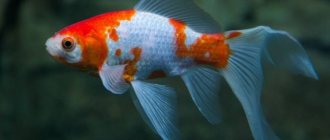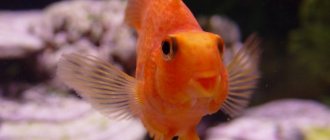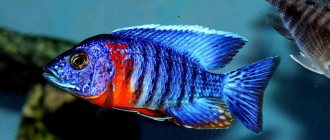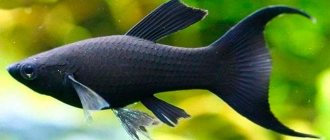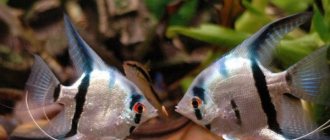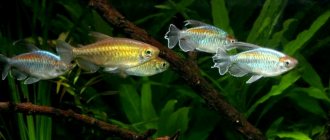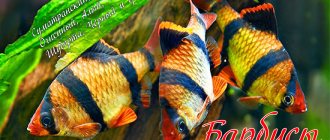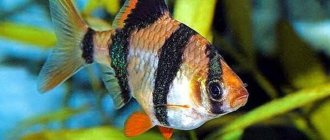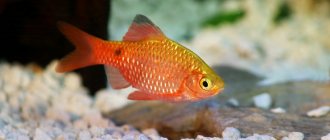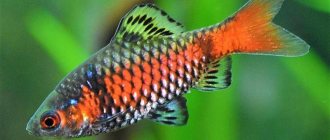5
(4)
Today, the shark baloo is one of the most interesting representatives of the underwater fauna. It’s worth noting right away that he is in no way related to the famous bloody predators. It is called so solely because of its certain resemblance to a shark. But, despite its rather menacing appearance, it is a completely calm and peaceful fish that does not pose a danger to its neighbors in the aquarium (of course, if they are not so small that they can be eaten).
general information
Shark Baloo, also called Balanthiocheilus blackfin, shark barb, has a deceptive appearance that makes the fish look like dangerous, cold-blooded predators - sharks. But no matter what external similarities there may be, mini-sharks are too friendly and do not have a ferocious disposition.
Baloo sharks do not show aggression and can peacefully coexist with other peace-loving and non-territorial fish of approximately the same size. They can also feast on smaller neighbors, considering them as food.
Baloo prefer to live in the middle layers of the aquatic environment. If they are provided with suitable conditions, the fish will become a real decoration of an artificial reservoir. Representatives of the species have a peaceful disposition and rather large size . In the natural environment, 35-centimeter individuals are found; when living in an aquarium, they grow up to 25-30 cm in length.
They are school dwellers. Their community has a strict hierarchy, and its members adhere to certain rules. If you place no more than 5 fish in one tank, then the weaker ones will suffer from the dominant individuals. And the lone shark will become very aggressive and will not let its neighbors live.
Compatibility
Shark Barb is a fish that is easiest to work with if you initially purchased several individuals that develop together. With an established hierarchy, representatives of the species are not prone to particular conflicts among themselves and do not provoke their neighbors in the aquarium. Problems occur when Carp Sharks share a tank with slow-moving fish with bright colors and long fins (angelfish and goldfish), which they will then nibble on.
Small species like neons can become prey for Baloo.
Aggressive cichlids will push Shark Ball into regular skirmishes, as they are used to protecting their territory. Over time, weaker individuals will be injured and die, so compatibility is excluded. If you plan to introduce new fish, you can avoid difficulties by choosing:
- aquarium catfish;
- loaches;
- gourami;
- cichlids, which have a calm disposition;
- other barbs of medium and large sizes.
What should an aquarium be like?
These fish are active, mobile, but shy; they require free space for swimming and vegetation, which they use to hide. To make your pets comfortable, they need to provide them with a suitable home:
- It is important to consider the size of the individuals and schooling - the fish will need a large, spacious tank. Juveniles can be kept in a 300-liter tank, but adult fish will require a 400-liter tank or larger.
- It is advisable to choose an oblong rectangular container, the length of which is at least 2 meters.
- The container must be equipped with a lid - balus can jump out of the container and die.
- The aquatic environment must be clean - as for other river inhabitants, this is very important for the Balu.
- A filtration system is a necessary piece of equipment; it must be a powerful external device that creates an intense flow.
- Decor is important not so much for the fish as for the appearance of the reservoir. The main thing is that the fish have room to move freely. It is recommended to plant plants in the corners and along the back wall; a snag can be placed in the center of the tank.
The owners note that these mini-sharks look most impressive against the background of dark soil and the darkened back wall of the aquarium; their scales literally sparkle and shimmer.
One of the features of shark balus is their habit of searching for food at the bottom, picking up the remains, thereby maintaining its cleanliness. Unlike most bottom dwellers, these fish pick up food carefully, without uprooting vegetation or stirring up the water. These fish are also capable of making sounds reminiscent of slurping.
Breeding
Although there are reports of successful aquarium breeding of Balu sharks, the majority of commercially available fish come from farms in Southeast Asia. It is much easier to purchase this fish than to breed it.
First of all, remember that a sexually mature male grows up to 30 cm, and it is not recommended to keep him in aquariums smaller than 400 liters in principle.
If you keep several fish, then 600 liters or more. Despite its size, it is a fairly peaceful fish, but breeding it is difficult.
Unlike many small fish that become sexually mature at an early age, the shark baloo does not mature until it reaches 10-15 cm.
It is very difficult to accurately determine the sex of a fish; based on this score, keep a flock of 5-6 individuals. Males grow somewhat larger than females, and females have a slightly rounder belly.
It will take a long time before you can roughly determine the sex, and even experienced aquarists make mistakes.
To prepare the fish for spawning, prepare an aquarium of 200-250 liters, with a water temperature between 25-27 C. Do not plant tightly with plants, the fish need a lot of space to swim.
It is better to have several large bushes of plants in the corners. If you plan to raise the fry in the same aquarium, then it is better to leave the bottom clean.
This bottom is easier to clean and easier to observe the eggs. To keep the water clean, install an internal filter with one sponge, without a lid. This filter cleans the water quite well and does not pose a danger to the fry.
It is believed that before spawning, the male and female perform a kind of dance. At least the breeders believe that the mating dance takes place.
After the female has laid eggs, she flies them around the aquarium so that the male can fertilize the eggs with milk. In order to increase the chances of fertilization, it is important to have a current in the spawning area, which will spread the milk over a larger area.
Once the spawning is over, the male and female do not pay any attention to the eggs. In nature, balus join various flocks for mating and, accordingly, do not care for the eggs in the future.
Parents tend to eat the fry and the game, so after spawning they need to be removed immediately.
Habitat of individuals in nature
The first to describe these aquatic inhabitants was Bleecker, and this happened in the mid-19th century. The habitat of these fish is the south-eastern part of Asia; they are found in Sumatran reservoirs, in Kalimantan and the territory of Malacca. Previously, it was believed that sharks came from Thailand, the Mekong basin. But at the beginning of the last century, this theory was documented to be refuted - there are no shark barbs in this region.
Due to a sharp decline in shark populations, shark barbs were included in the Red Book as a species on the verge of extinction. Researchers have found that the number of these fish in the natural environment is steadily declining, but the reasons for this have not yet been identified. This situation is not associated with the catching of barbs for aquarium keeping. Most likely, the deterioration of the environmental situation is to blame.
Individuals more often go on sale from Thai and Indonesian farms, where they are raised and bred using hormones.
Purchase
Baloo is not one of those fish species that cannot be found in pet stores. The cost of individuals varies from 300 rubles and above. The price depends on color, size, age. Many online stores in Moscow offer delivery of live goods to all regions of Russia.
When purchasing, you should pay attention to the appearance. The scales should not be ruffled. The eyes are bulging. You cannot buy these fish for a small or densely populated aquarium. Also, don’t think about gender. The greatest desire will not allow you to discern sexual characteristics while the Barb is less than 15 cm.
Appearance description
These freshwater fish resemble sharks, but are not sharks. They have their own characteristic features that are different from shark representatives:
- individuals have an oblong, torpedo-shaped body;
- large eyes - they help the fish find food;
- the pectoral fins are almost transparent; when looking at the fish, they are not immediately noticeable;
- the dorsal fin is short in length but of decent height, really reminiscent of a shark;
- the body is covered with silvery scales;
- on the fins there is a stripe of white or yellow color, edged in black.
With good care, the life expectancy of individuals is about 10 years.
Diseases and prevention
Shark Baloo is characterized by a high level of immune defense. However, if there are errors in the organization of the artificial system or the creation of a stressful situation, the owner can observe the development of diseases:
- Ichthyophthiriasis (semolina). Formation of white dots on the fins and body. It is treated with soda and iodine, as well as medications.
- Poisoning. Fish rise as high as possible in search of air, and the development of bulging eyes is observed. To normalize the condition, you need to change your diet and bring the water quality back to normal.
- Hypoxia. Incorrect breathing rhythm, noticeable swelling of the gills and rise to the surface layer. The owner is required to establish aeration in the tank.
- Aeromonosis. Inflammation of the body with hemorrhages and bulging eyes, ruffled scales. In the first stages, the disease is treated by adding salt to the aquarium - 5 g per 10 liters. With serious progression of the pathology, special medications are required.
Difficulties of content
Barbs of this type have good health and, if well maintained, practically do not get sick. They do not require special nutrition, as they are practically omnivores. The fish do not know how much to eat, so the owner should take care that his charges do not overeat.
The biggest difficulties in keeping these inhabitants are related to their size. For aquarium fish they are quite large, and standard aquariums quickly become cramped.
Video on the topic
Watch the video about the shark barb:
Those who intend to purchase these shy but peaceful fish should weigh the pros and cons. The life and health of Barbus will depend on proper care and space for pets to live. Responsibility at the acquisition stage will avoid many difficulties and disappointments in the future.
- Related Posts
- Breeding Sumatran barbs
- Aquarium fish Schubert's barb
- Veiled fire barb: maintenance rules
Diet and feeding regime
Baloos have an excellent appetite and are not picky. They can eat almost any food that is used to feed aquarium fish. Ball owners need to take into account two features:
- Plant food makes up approximately 10% of the total diet of individuals - the fish can be treated to finely chopped vegetables and herbs or ready-made dry food containing spirulina.
- The rest of the fish’s diet consists of insects and larvae, but feeding bloodworms to the ball is not recommended - the weak stomach of the fish is not designed to digest such hard materials.
Young animals can be treated to large daphnia; adults will not refuse earthworms cut into pieces or balls of Aulophorus worms, which many aquarists grow at home. It should be borne in mind that these inhabitants love to eat in the middle layer of the aquatic environment; they can also pick up food from the bottom, but when they lack the basic diet.
Habitat
Mainly found in rivers, but also in natural lakes in Thailand, Malaysia, and Laos. Found on the islands of Sumatra, Kalimantan and Borneo.
Since 1996 the species has been listed as Endangered on the IUCN Red List and it is almost certain that wild fish are not available in the aquarium trade, with 100% of those traded coming from commercial fish hatcheries.
How to care for your home
There are no difficulties in this matter; standard procedures are required:
- weekly water change by 25%;
- food remains are removed daily.
It is important that the water remains clean. Since any biological waste decomposes quickly enough, poisoning the aquatic environment with toxins, it is necessary to promptly clean the tank from food debris. Certain water parameters should be maintained:
- acidity – 6.0-8.0;
- hardness – 5.0-12.0 dGH;
- temperature – from 22° to 28°C.
To monitor the state of the aquatic environment, it is better to equip the aquarium with measuring instruments and periodically evaluate the indicators.
Arrangement and parameters of the aquarium
The large size of the shark ball requires keeping it in a spacious aquarium of at least 200 liters. 5-7 individuals perform better and are more interesting to watch than one fish. Lonely fish can become aggressive towards other aquarium inhabitants. If the aquarium volume is insufficient, growth slows down and lifespan is shortened.
Bala sharks are very mobile, swim quickly and therefore require a large amount of space free from plants.
All types of vegetation are suitable for young fish, and for adult fish only plants with hard and strong leaves, for example, Vallisneria, Anubias, Echinodorus. It is better to use stones and driftwood rather than vegetation as decorative elements. They can burrow into the ground, so it must be sandy.
A feature of this fish is its extreme sensitivity to stress. Sudden movements when cleaning the aquarium lead to fish hitting the glass, causing damage to themselves, or jumping out of the aquarium. In this regard, the presence of a cover glass is mandatory.
Water parameters
Temperature: optimal 23-27° C (lower limit 18, upper 35);
pH: 6.5-7.5; Hardness: 12-16° dH (up to 20). The shark barb, which lives naturally in fast rivers, will be very happy if you use a pump to create a current in the aquarium. Filtration with aeration is required powerful. Water changes are carried out weekly from 30 to 50%.
The temperament of tricolor sharks is exactly the opposite of their name; the fish are peaceful and compatible with any calm species: iris, gouramis, barbs, rasboras, zebrafish, corydoras, tetras, minors.
They are not able to protect themselves from predatory aggressive fish that bite off the fins of balantiocheilos, for example from large cichlids.
Who do small sharks get along with?
If you do not take into account the dominant behavior of males during the spawning period, then shark barbs are quite easy-going. They get along well with fish of the same size that are not highly aggressive or territorial. They can be placed with:
- other representatives of the barb species;
- gourami;
- minors;
- rasborami;
- iris;
- tetras;
- catfish.
Life will not be sweet for a ball with large, angry cichlids, which, even if they are inferior in size, are capable of terrorizing their neighbors to the point of death. Slow, phlegmatic angelfish are not the best company for barbs. Moreover, it is the latter who will not like the fussy and overly active mini-sharks, which cause irritation to them.
Peaceful and non-conflict baloo, however, can cause mischief by pestering neighbors with luxurious fins, mercilessly cutting them off. Therefore, it is not worth placing them in the same aquarium with veiled representatives of the underwater world. Baloo sharks are not predatory fish, but they are capable of swallowing small fellows - neons, zebrafish, guppies and other viviparous fish of modest size.
Description and natural habitat
Shark Baloo is a freshwater fish belonging to the carp family. The body has an oblong shape with compression on the sides, covered with large scales that imitate a shiny effect. The silver color is uneven: a light shade is observed on the stomach, the back is darker. Factors by which the resemblance to a shark was determined and the species was named:
- large height of the dorsal fin and the shape of the entire plumage;
- speed of movement;
- almost non-stop activity.
Photo gallery of Shark Barbs:
The caudal and dorsal fins are light yellow in color, with a wide black border towards the end. Baloo's pectoral fins are almost colorless and are difficult to notice upon inspection. The eyes are enlarged, which helps to quickly find food and identify danger in time.
If Shark Baloo is kept in an aquarium with optimal conditions for itself, it lives up to 10 years. With unsuitable water and minimal space, individuals die within a year.
They are prone to a gregarious, conflict-free lifestyle with their own hierarchy. At least five Shark Barbs are recommended for 1 aquarium, since in quantities of 1-2 fish behave timidly and become stressed.
In the description of Shark Baloo, a weak expression of sexual dimorphism is noted. It is possible to distinguish a male from a female only when the fish grow to 15 cm. At this moment, females are distinguished by their rounded abdomen.
The species inhabits the waters of Southeast Asia and can be found on the islands in the western part of the Malay Archipelago. Prefers to swim in large rivers with clean water and high current speed. Shark Barb is a species evenly distributed throughout all layers of water. The number of individuals in natural conditions is declining, which is associated with global water pollution and littering of the bottom, so many fish sold in stores are bred on farms using hormonal agents.
Spawning preparation and reproduction
To obtain offspring, you should prepare a separate, 200-250-liter tank, into which water is taken at a temperature of 25-27C:
- It is possible to plant greenery in the tank, but not extensively;
- if the fry remain in it, then it is advisable not to put anything on the bottom - it is easier to monitor its cleanliness and the eggs;
- It is advisable to equip the spawning tank with an internal filter that has one washcloth - it will perform its functions well and is not dangerous for children.
Breeders note that a couple ready for spawning can be caught performing courtship dances, after which the female lays eggs, waving them around the tank. It’s good if there is a good flow in the container, which will make its task easier. The male goes about his business - fertilizes future offspring with milk. When the process is completed, the parental function of the Balu also ends - they do not burden themselves with special care for the eggs and do not show any interest in them.
In the natural environment, individuals mate not only within the pack, but also with individuals of other families, and therefore do not care for the offspring. Parents are not averse to eating eggs and even fry, so they must be immediately expelled from the spawning grounds. Babies that hatch from eggs almost from birth have to worry about food and safety themselves, which many of them cannot cope with. But in an aquarium their chances of survival are much higher.
Representatives of this species are ideal for living in a large, spacious tank. These fish literally fascinate, attract attention, with their beauty and graceful appearance. They reek of danger, which they actually do not represent. Naturally, they are not suitable for a modest aquarium, nor for keeping one individual and two or three fish.
Nuances during reproduction
In aquariums, fish reproduce very rarely and reluctantly. This process is expensive, long and often fails without special hormonal injections. Firstly, the fish will reach sexual maturity only at four years of age. And secondly, you will need a special spawning tank of a fairly large capacity (1200 liters minimum) with a length of at least two meters, where two mature males and one mature female are placed.
Make the water in the spawning tank colder, but softer than in the main aquarium (then you need to increase the temperature), cover the bottom with a thick layer of moss or mesh. It is advisable to feed the female with rich plant foods, and the males with rich protein and animal foods.
During spawning, one individual produces 10 thousand eggs. Then the fish need to be transplanted back. To protect against fungal diseases, it is recommended to add methylene blue (or another antifungal drug) at this stage. On the third day, methylene blue is removed with the help of coal. The appearance of the fry can be expected in two days, and after three days they are already swimming in a school and willingly eating living dust. Not every aquarist will decide on such complex breeding and further care. Many admit that it is much cheaper to buy or order them specially.
Photos of sharks
Food preferences
We sorted out the compatibility of the shark ball. What to feed this handsome guy? These fish eat everything and are unlikely to refuse the food offered. Baloo is eaten throughout the day. Both live and dry food are suitable for them. In order for a small “shark” to feel good, its diet must contain plant foods - up to 15%. These include spinach, lettuce, cauliflower, and green peas.
In their natural habitat, fish happily eat insect larvae, insects themselves, phytoplankton, and small crustaceans. Fish kept in an aquarium should not be fed with the same dry food all the time. The fact is that the ball gets tired of one type of food and wants variety.
If it is not possible to feed the fish with food, then you can give them minced lean beef or minced fish. Adult fish can be treated to shrimp, mussels and earthworms.
The shark feeds in any layer of water. He can even take food from the bottom. With good nutrition, balus can double in size in a year.
Diseases
Domestic sharks have strong immunity. With improper care and non-compliance with flocking, the following are susceptible to the ball:
general characteristics
This fish, in addition to the name shark ball, has many more names:
- shark ball;
- shark barb;
- fire-tailed barb;
- Balanthiocheilos blackfin;
- tricolor shark;
- silver shark;
- balanthiocheilus.
Did you know? Shark Ball
—
It is an endangered species of freshwater fish. They are listed in the Red Book. However, the reasons for their extinction are still not known for certain. It is assumed that the fish can hardly tolerate environmental pollution and therefore disappear. Or perhaps they are simply caught en masse for aquarium keeping.
Description and dimensions
The fish really resembles a shark in appearance. She has a similar body structure and high-set, pronounced fins.
Some experts claim that it is more similar to an ordinary roach, but the shark barb is much more interesting than this river fish, and its fins perpendicular to the body give it a certain cockiness and originality.
Shark baloo is characterized by the following external features:
- the body is oblong, elongated and laterally flattened, which is why it appears almost flat;
- The head is not large, but its eyes are disproportionately large and have a clear and contrasting pupil. The mouth is large and located below;
- the fins are erect, sharp, the upper one is completely vertical, triangular in shape, and the tail one is forked. All fins are bordered along the edge with a black stripe, and in the middle they are either completely transparent or with a slightly yellowish tint;
- The scales are large, rounded and silvery, mirror-like, shiny in color.
These are large fish, in aquarium conditions they grow mainly up to 20–25 cm in length, and in nature they can reach 35 cm. In addition, these fish are schooling and do not live alone, so one individual is not enough. Accordingly, the container for them should be very spacious.
The lifespan of aquarium sharks is 10-12 years.
How to distinguish a female from a male
Fire-tailed barbs do not have obvious sexual demorphism. At a young age, fish do not differ at all from each other in gender.
They reach sexual maturity in the 2nd or 3rd year of life. It is from this moment that it becomes possible to distinguish between a male and a female, but only during spawning.
To do this, it is necessary to compare two individuals of the same age with each other: the female will be larger, with a more fleshy physique and a more plump, rounded belly, while the male will be smaller and more compact. In addition, males have a more cocky character, so they can also be distinguished by their “rebellious” behavior.
Did you know? Fire-tailed barbs are so active and full of energy that in nature they purposefully avoid streams with a slow flow, inhabiting only stormy and clean rivers.
What to feed a shark barb
In nature, the Bala shark eats insect larvae, algae, worms, and living plants. He has a good appetite, but a weak stomach. It is not recommended to feed them bloodworms in an aquarium, as it leads to digestive upset.
For feed, choose high-quality dry, slow-sinking feed. TetraMin Granules are suitable for young animals, and TetraMin XL Granules for adults. These feeds slowly get wet and sink. Therefore, the fish will be able to eat them in the water column.
You can supplement your diet with TetraPro Energy flakes for active fish and frozen brine shrimp. A couple of times a week, give the fish vegetables soaked in boiling water: lettuce, zucchini, cucumber, pumpkin.
Feed your pets in the morning and evening in small portions.
Female
What do sharks get sick of?
Shark baloo is in good health. The main diseases that can affect the fish are carp rubella or aeromonosis.
Aeromonosis is an infectious disease of fish. It is expressed in the fact that the scales begin to ruffle. Most often, fish in overcrowded aquariums where the water is constantly polluted are exposed to the disease. A sick fish changes its behavior. She refuses to eat, often lies down on the ground, becomes lethargic and inactive. The fish's abdomen is inflated, and blood stains are visible on the body and fins. In the acute phase, the scales ruffle throughout the body and fall off.
Is it possible to cure a pet? Usually this can only be done at the initial stage of the disease. The disease is difficult to cure. Bacillin-5 or soluble streptocide are used for treatment. In the first case, there is a daily water change up to 90%. In the second, 15 grams of streptocide are dissolved in 100 liters of water for a week.
In most cases, the shark baloo dies from this disease.
